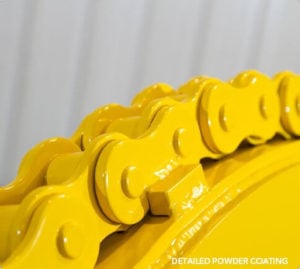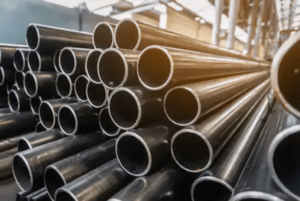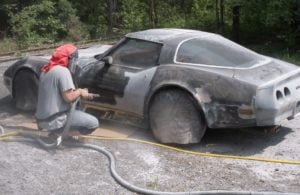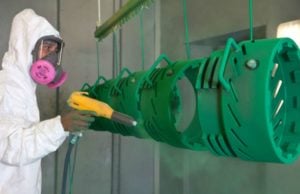Sand blasting and soda blasting are two of the primary ways to clean or prepare a surface for industrial coatings. The two are similar when it comes to their processes and equipment, but the difference comes down to their materials and applications. In some instances, either one can be used while sometimes one has a clear advantage over the other.
What exactly is the difference between the two? Is one better than the other? How much does each one cost, and what are their benefits? There are many questions to answer before choosing one method. Knowing the purpose of each process will help narrow the options for different projects and ensure optimal results with beautiful finishes.
Related: Everything Engineers and Product Manufacturers Need to Know About Industrial Metal Finishing
What is Sand Blasting?
Sand blasting, also called abrasive blasting, is the older and better-known option of the two. This process involves using compressed air to force abrasive material at a surface in order to remove rust, paint, or debris prior to applying an industrial finish like paint or powder coating.
Contrary to its name, sand is no longer the primary material used in sand blasting. Sand is less durable and effective due to its tendency to break down and turn to powder on impact. In this way it is similar to the material used in soda blasting. Other media like glass or plastic beads, steel grit, and even walnut shells are better suited to use in sand blasting. Some of these materials can be recycled, as they are much stronger than sand and are less likely to be destroyed.
Sand blasting essentially provides the same type of finish as hand sanding, but more evenly and efficiently. It requires some specialized equipment like an air compressor, blast cabinet, and blast room. The equipment used depends on the method that best suits the project at hand.
Portable air compressors are pressurized and filled with blasting material and can be transported to the project site and the sand blasting is done in a more open space. Blast cabinets are ideal for recyclable material, as they collect the media after it has been used so it can be gathered for a future project. In this case, the operator performs the sand blasting with the piece in a small, enclosed cabinet. Meanwhile, a blast room serves a similar purpose to the cabinet, but on a larger scale. Blast rooms are used for vehicles, construction equipment, and aircraft, though dust and media collection systems can still make it possible to reduce waste and recycle materials.
Sand blasting is most often used on metal due to the strength of the media and air pressure. It is one of the most efficient preparation methods and the best one for rust removal. It cleans surfaces quickly, and because of the variety of media used in the process, its uses are just as versatile.
One of the most significant downsides to sand blasting is the health risk. Sand blasting creates a large amount of dust, which can cause respiratory problems, and pressurized application can cause burns on unprotected skin. There are also fall risks from media left underfoot, as well as excessive noise and heat potential. Most of these dangers can be addressed and prevented using the proper personal protective equipment (PPE).
What is Soda Blasting?
Soda blasting is a process much like sand blasting. The two can overlap in certain circumstances, but in general, they serve different purposes. The main difference lies in the material.
Soda blasting is a newer form of abrasive blasting that was invented in the 1980s and is milder than sand blasting. It uses sodium bicarbonate—otherwise known as baking soda—and, with equipment similar to that used in sand blasting, blasts the particles against a surface to clean it. While soda blasting can be used to smooth surfaces for coating preparation and remove rust, it is primarily used to clean.
Soda blasting is especially effective on surfaces like wood, chrome, and plastic. In other words, surfaces that are softer or require a gentler touch work well with this type of blasting, as it is less likely to damage the surface. Because of the low risk of distorting the surface, soda blasting is suitable for use on a wide variety of surfaces. It is especially practical in automotive restoration, cleaning wooden surfaces like decks and doors, and cleaning in masonry applications.
Sodium bicarbonate is also a deodorizer. This makes it ideal for mold removal and cleaning up after fire damage. It is also a more fragile material than those usually used in sand blasting, which means it breaks upon impact and creates a lot of dust. For this reason, respiratory protection is needed.
How Are Sand Blasting and Soda Blasting Different?
The differences between sand blasting and soda blasting go beyond their applications and materials. Where sand blasting might cause damage, soda blasting is ideal for the job. Meanwhile, where soda blasting can be used on the same surfaces and for many of the same purposes, sand blasting is more efficient and can clean or strip a surface of rust and paint much more quickly than soda blasting.
Sand blasting is applied using much greater pressure than soda blasting. Soda blasting may use only 20psi, but sand blasting can use anywhere from 70 to 120psi. This alone creates a vast difference in how well they work in various scenarios, as air pressure is one of the main factors in their strength.
Sometimes, however, soda blasting can offer more advantages in rust removal. Not only can it remove the rust, but it prevents it from forming again. With sand blasting, the industrial finish has to be applied immediately because of the danger of flash rusting. However, soda blasting creates a protective film over the surface after blasting and allows for some time to pass between preparation and coating, as it prevents the surface from rusting quickly. Once the final coating is ready to be applied, the sodium bicarbonate film can be removed with water and vinegar or scrubbed away, ready for the new coat.
Another key difference is its environmental impact. While sand blasting media is sometimes recyclable, it also is not always environmentally friendly. Materials like corn cobs and walnut shells are an exception here, as they are biodegradable, but other materials like metal and plastic beads are not. Sand blasting also creates much more dust than soda blasting, which means that when the materials used are already harmful, this creates airborne hazards as well as potentially toxic residues.
Sodium bicarbonate is much better for the environment. The material is water-soluble and will not build up in water or contaminate living spaces of humans or wildlife. Since baking soda is actually edible, this means it will not cause harm if ingested—as long as it does not have grease or paint mixed in with it. Sodium bicarbonate does create dust in the same way sand blasting materials do, but it is less dangerous to breathe. However, that does not mean protective equipment should not be used.
Sand blasting and soda blasting also have different health impacts beyond the environment. While the dust from sand blasting can cause silicosis among other respiratory illnesses, it is less dangerous to breathe particles from sodium bicarbonate. However, PPE is still necessary, as breathing too much of any substance can cause problems.
How Much Do Sand Blasting and Soda Blasting Cost?
Between the two, soda blasting is slightly more expensive. This is to be expected, considering many environmentally friendly options do cost a little more. In some cases, this can be well worth the investment based on equipment performance and the end result.
Starting materials for soda blasting include a blast generator, compressed air supply, a blast hose and nozzle, and a moisture decontamination system, as well as sodium bicarbonate as a recurring cost. Sand blasting, on the other hand, requires an air compressor, blast pot, and a blast gun, which in total costs less than the soda blasting materials. Plus, when it comes to sand blasting, there is the potential for reusable material, which is not the case with soda blasting.
Sand blasting equipment costs also vary depending on the scale of the projects for which it will be used. A portable sand blasting system is much less expensive than large scale industrial equipment. Basic portable systems can be found for around $30. However, industrial equipment can cost up to $50,000, which is likely not in a single individual’s budget.
Small scale soda blasting equipment can start at hundreds to several thousand dollars. This may be a manageable cost for some people, but the cost is much higher than finding a sand blasting system for $50 or less. When considering the environmental as well as health and safety impacts, it may be worth spending more for this type of system.
Which is Better?
Whether sand blasting or soda blasting is the better option comes down to the type of project for which they are needed. Sand blasting is excellent for tougher materials like steel, aircraft parts, and concrete while soda blasting is ideal for wood and masonry. Frequently the industries in which these two processes are used overlap, though their applications can be totally different. The present situation will ultimately determine the better option.
When is Sand Blasting Better?
Sand blasting is generally better when a stronger material is involved. This means if rust needs to be stripped from steel, sand blasting may be the best bet. The media used in the process is more durable, which means it will be more efficient at taking away rust and paint from heavy metal, as well as cleaning the surface prior to applying the industrial coating.
Sand blasting is best for heavy machinery, too. It is better at removing grease than soda blasting, and it will remove anything stuck on the surface. In these cases, soda blasting may only remove grease, without removing the paint if the paint is not already chipping or otherwise weakened. Sand blasting has a broader range of media choices, too, which means it has a wider range of applications. It can be used on softer surfaces when working with walnut shells or corn cobs, while harder surfaces may call for steel grit.
Sand blasting is often used in the automotive industry, but this is not always the best application for it. It can damage windows and vehicle bodies, so it may not work as well as soda blasting. At the same time, the film created by soda blasting can cause problems when painting, which is why sand blasting is the more common choice in such cases. Sometimes the best choice comes down to the skill of the person performing the job.
Sand blasting should be used in instances where a stronger medium would benefit the project. If there is a concern about environmental factors, it may be a good idea to choose a recyclable medium where possible.
When is Soda Blasting Better?
Soda blasting, despite its softer materials, has just as many uses as sand blasting. Soda blasting is often better for cleaning surfaces, especially when it comes to wood and easily damaged materials. It also works best for removing weaker imperfections from surfaces. For example, because mold is typically softer, this makes it easier to remove by way of soda blasting. The same goes for smoke damage. The strength that comes with sand blasting may actually be a disadvantage in these cases.
Soda blasting works well in automotive applications where sand blasting is not suitable, like if there is a danger of breaking vehicle windows. It is also a good option for cleaning aluminum sheets, as it is less likely to damage the material. Some sand blasting media also reacts with certain surfaces, like aluminum and other metals, which soda blasting does not.
Soda blasting can be an excellent option for use on metals and preparation for industrial coatings. While sandblasting should be used for especially difficult rust or paint removal, soda blasting can be perfect for this process in situations where a lighter blasting is needed. If the time between preparation and applying a new coating will be more than a few minutes, soda blasting can prevent flash rusting and reduce future problems with the coating. In this application, it is crucial to fully remove the film on the surface before it is coated.
Overall, soda blasting is more flexible and versatile than sand blasting. It is less extreme and can be used on a wider variety of surfaces, despite the greater range of sand blasting media types. Soda blasting should be used if there is a concern about surface damage or if a softer medium would be as effective in doing the job. Sand blasting also does not have many of the beneficial properties that soda blasting has, like deodorization and sanitization.
Soda blasting is also a better option when it comes to personal safety and environmental wellbeing. If the concern is with cost and the project can be completed as effectively with stronger material, sand blasting may be a better choice. There are also applications where, while soda blasting can be beneficial because it leaves a protective film over the surface, this can also be a detriment. For example, if the film is not entirely removed or neutralized, it can prevent paint, epoxy, and other industrial coatings from adhering to the desired surface.
While sand blasting and soda blasting are similar in many ways, there are significant—and subtle—differences that set them apart. They are both applied in many of the same industries, and in many ways their functions are equal in terms of how beneficial they are. However, that does not mean they can always be implemented in the same ways. Their functionality largely depends on the needs of a given job, and when soda blasting is used in place of sand blasting (or vice versa), it can be detrimental to the project.
Some aspects of soda blasting and sand blasting come down to preference, but the majority of the time, one option is clearly better. To decide which to use, materials, equipment cost, and media capabilities must be considered along with the environment, health, and safety risks. Knowing the difference between sand blasting and soda blasting can mean the difference between a successful job and a failed project.
Related: Is Abrasive Blasting the Right Metal Finishing Solution for You?






